di Marta Lock

Giovane, sensibile, attenta osservatrice delle pieghe più profonde che si nascondono dietro gli sguardi di tutte le persone che incontra sul suo cammino, Elisa La Manna pur avendo studiato all’Istituto d’Arte dove ha conseguito il diploma nel 2011 comincia a dipingere, o meglio a esercitare regolarmente la pittura, solo nel 2020 forse perché proprio in quel periodo più buio della storia del Ventunesimo secolo la sua interiorità ha sentito il bisogno di trovare uno sfogo, un canale liberatorio attraverso cui gridare i disagi, le paure, le incertezze ma anche le manipolazioni a cui l’uomo contemporaneo è costantemente sottoposto. Da quel momento in avanti il percorso artistico diviene un susseguirsi di mostre e partecipazioni a concorsi pittorici durante i quali viene notata e apprezzata dal pubblico e dagli esperti ai lavori proprio grazie alla sua capacità di tirare fuori verità a volte anche scomode eppure innegabili, davanti alle quali l’osservatore non può che riflettere lasciandosi trasportare dall’introspezione dell’artista; per questa forte tendenza all’approfondimento e all’analisi oggettiva delle imperfezioni, delle gabbie confuse con la libertà, dei condizionamenti inconsapevoli, ma anche per la decontestualizzazione degli elementi essenziali, quelle parti in evidenza che vanno a comporre il messaggio finale e che, sebbene appaiano non attinenti gli uni agli altri in realtà costituiscono lo sguardo ampio e i concetti base della lettura trasversale dell’osservato tipico della La Manna, il suo stile si inquadra nel Surrealismo Metafisico. In virtù degli studi accademici riesce a sperimentare e mescolare tecniche esecutive funzionali ai messaggi che desidera imprimere sulle sue tele, perciò a una base di colore acrilico aggiunge talvolta foglia oro, resina epossidica, caffè, vino, materiali insoliti che le consentono di mettere in sinergia l’intenzione con l’azione, il sentire con il gesto creativo, la mente con l’emozione. La sua giovane età non le impedisce di andare fino in fondo ai significati che la vita spesso nasconde, anzi in realtà forse è proprio in virtù della naturalezza nello sguardo che riesce a porsi domande che la moltitudine rinuncia a porsi, perché è più facile fingere di non vedere, abituarsi, allinearsi piuttosto che prendere atto di realtà scomode. La tela Modern slave
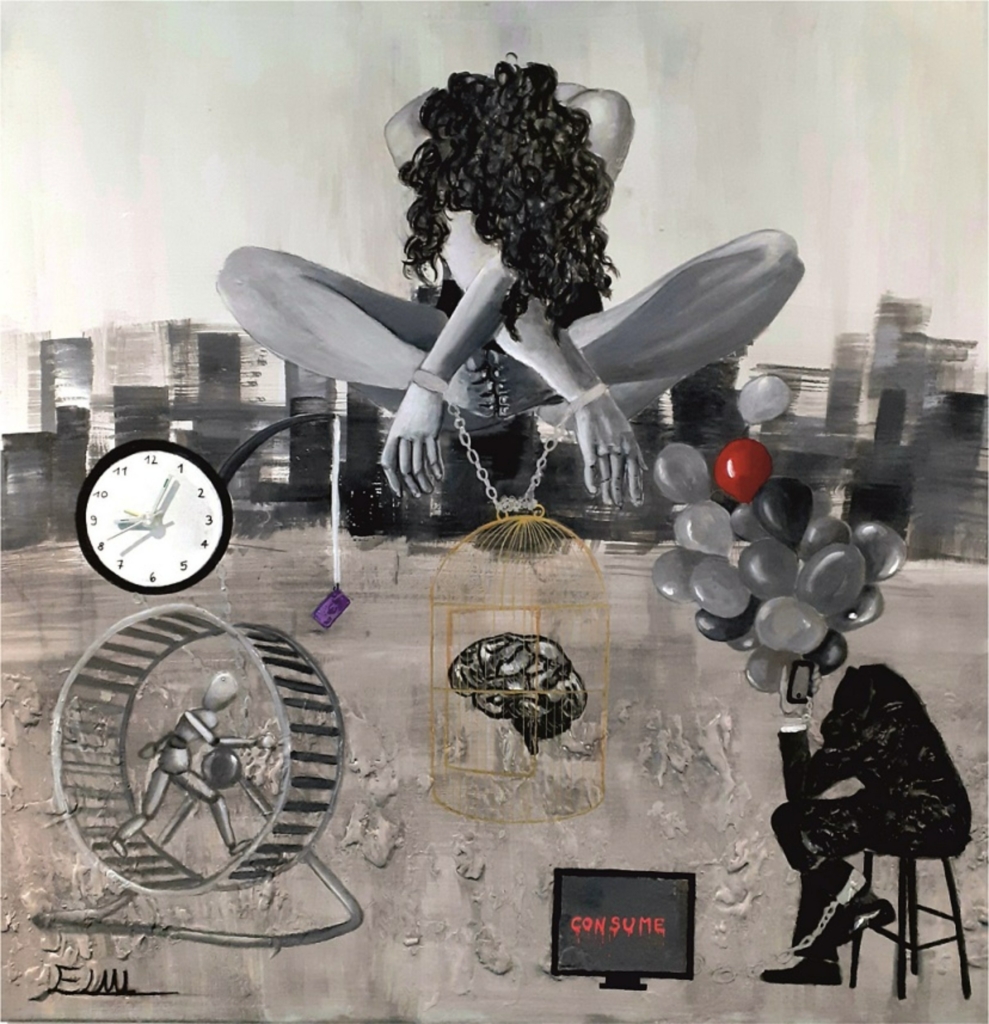
pone l’accento su quella rete di innovazioni e comodità attraverso cui l’uomo e la donna contemporanea si sentono liberi, come il potere di acquisto, il tempo da riempire con mille impegni, gli smartphone grazie ai quali si può essere collegati con il mondo in un solo click, i mass media grazie ai quali tutto è fruibile in tempo reale; eppure nell’opera tutto questo non ha nulla di positivo, al contrario ciò che apparentemente dovrebbe rendere migliori, più consapevoli, più felici, rappresenta una prigione dorata dentro la quale l’anima, l’interiorità, soffre perché si sente sola, inaridita, impotente davanti al circolo vizioso di causa ed effetto da cui sembra impossibile uscire e che è rappresentato dall’artista da un criceto su una ruota girevole. E ancora nel dipinto Influenza mediatica
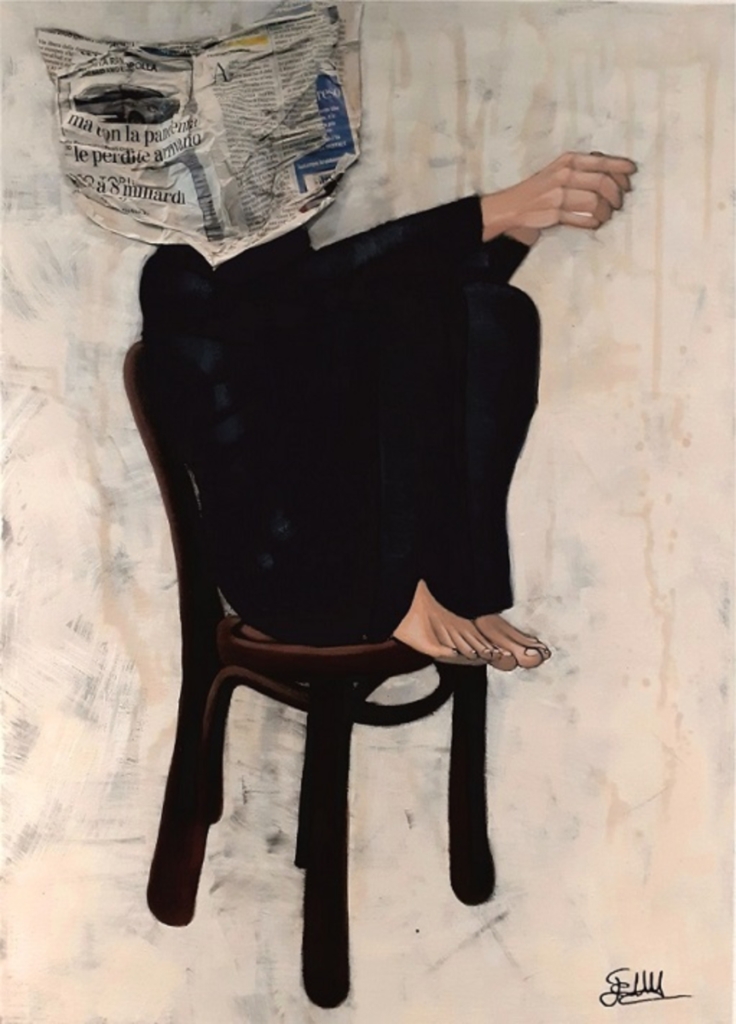
Elisa La Manna sottolinea quanto l’essere umano sia incapace di formarsi un pensiero critico a causa della superficialità con cui a volte affronta i temi importanti della contemporaneità, fidandosi di una voce unica che monopolizza il pensiero inducendo il ricevente a dare per buona una sola versione, senza approfondire e aprirsi a contraddittori funzionali ad avere una visione più ampia e imparziale. Ancora una volta dunque l’artista evidenzia quanto la società tenda a voler condizionare e a fagocitare l’individualità del singolo che si trova davanti alla scelta se uniformarsi e rinunciare a se stesso oppure se andare contro corrente pur sapendo di dover essere una voce fuori dal coro, più solo forse ma sicuramente più libero. Andiamo ora a conoscere in maniera più approfondita la talentuosa artista piemontese.
Elisa, il suo cammino artistico si è avviato a molti anni di distanza dal suo diploma, ci spiega cosa l’ha tenuta lontana dalla pittura e come mai l’inizio del vero e proprio approccio alla tela è coinciso con il delinearsi dell’evento pandemico che ha immobilizzato l’intero mondo?
Ho frequentato l’istituto d’arte per tre anni; per vari motivi e necessità, in parte condizionate anche dall’ambiente esterno, ho avuto un periodo di transizione scegliendo un altro percorso credendo fosse giusto per me, ma che nel tempo oltre a farmi stare male si è rivelato tutt’altro. La pandemia è stata una coincidenza, avevo iniziato ad avere l’idea di ricominciare a dipingere poco prima che iniziasse tutto; la reclusione a cui siamo stati obbligati subito dopo è stata come un dover chiudere una porta per aprirne un’altra all’interno della quale ho avuto del tempo per ritrovare me stessa e rimettermi in gioco in un percorso che ero già destinata a compiere malgrado fossi smarrita e confusa e dunque me ne fossi allontanata.
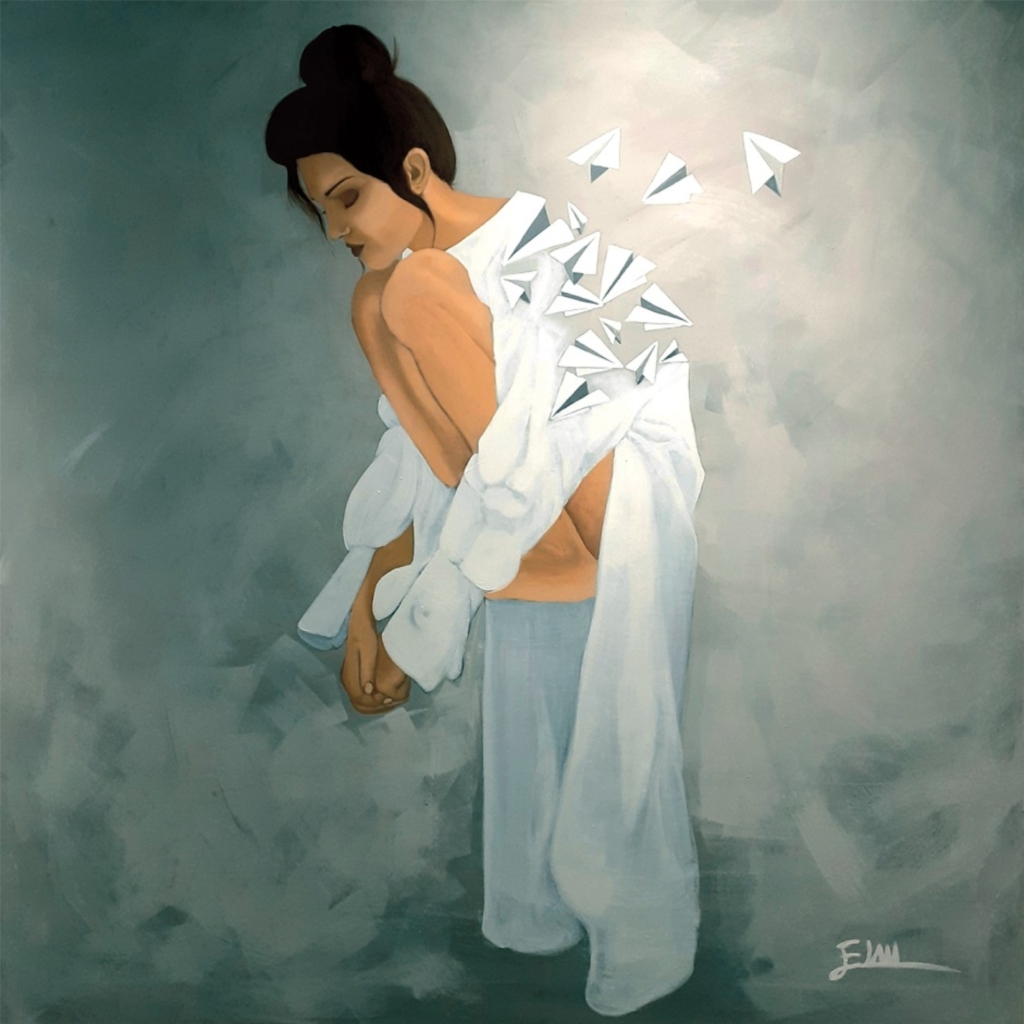
Il suo stile pittorico è decisamente coinvolgente grazie allo stile surrealista metafisico in grado di imprimere sulla tela impressioni ma anche pensieri e valutazioni sul vivere attuale; crede esista un modo per l’uomo moderno di uscire dalle gabbie dorate dentro le quali si trova? Può essere l’arte un mezzo per reclamare la libertà dell’individuo e per indurre le persone a farsi domande, andando più affondo della superficie su cui di solito si fermano?
Non credo che l’arte possa farci uscire dai condizionamenti poiché siamo talmente schiavi di un sistema dove ognuno guarda i propri interessi che ci si è dimenticati del bene comune; il dover rinunciare a tutte quelle comodità a cui la maggior parte di noi è ormai abituato porterebbe ad una tale crisi psicologica che inducono le persone a non rinunciarvi. Basta immaginare come sarebbe la vita sostituendo il nostro smartphone con un comune cellulare, o provando a smettere di lavorare per dedicarsi esclusivamente alla coltivazione dei propri bisogni e necessità. Siamo entrati a far parte di un circolo vizioso che rende troppo difficile un’inversione di rotta. Per la maggioranza è più facile seguire la corrente e non porsi domande che cercare di valutare e cambiare strategia. Fortunatamente non è così per tutti, le eccezioni ci sono sempre, ma la tecnologia, il vivere contemporaneo che ci è stato imposto può averci reso uniti sotto forma digitale ma divisi dal punto di vista umano. L’arte secondo me ha un ruolo importante da questo punto di vista, la libera espressione creativa è un modo per comunicare dei messaggi, un mezzo dove l’individuo possa rispecchiarsi e riflettere.
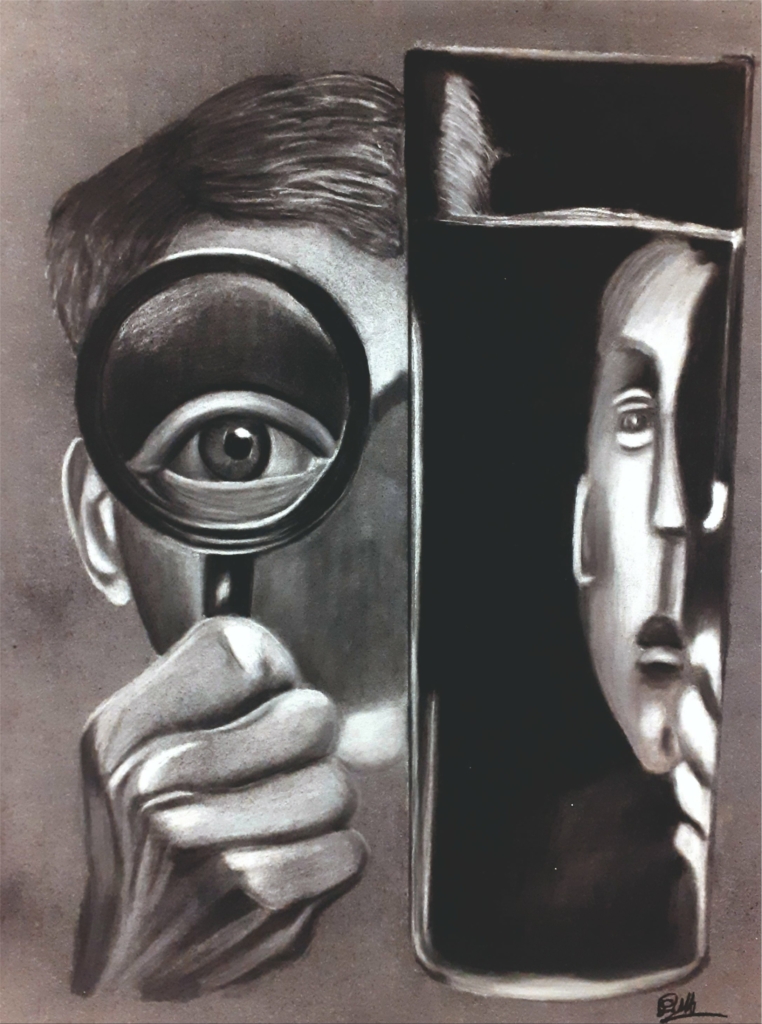
Qual è il messaggio che desidera emerga dalle sue opere? E come mai la scelta della Metafisica come approccio pittorico?
Sono sempre stata una persona riflessiva e mi è sempre piaciuto osservare le cose da un certo punto di vista. Nelle mie opere cerco di dare una narrazione che vada oltre l’apparenza, la realtà è osservata nelle sue tante sfaccettature, mi piace immortalare emozioni e situazioni vissute dall’individuo in un determinato contesto. Il messaggio che voglio far emergere è quello di soffermarsi per dare voce a emozioni e riflessioni che l’individuo nella sua quotidianità sfugge.
Ci sono maestri del passato che l’hanno ispirata o a cui si sente più vicina per intento espressivo?
Ho sempre avuto un debole per artisti come Klimt, Dalì, De Chirico e Frida Kahlo. Il Surrealismo e la Metafisica sono i movimenti artistici che mi hanno sempre appassionato di più; come intento espressivo mi sento più vicina proprio agli ultimi tre che ho citato.
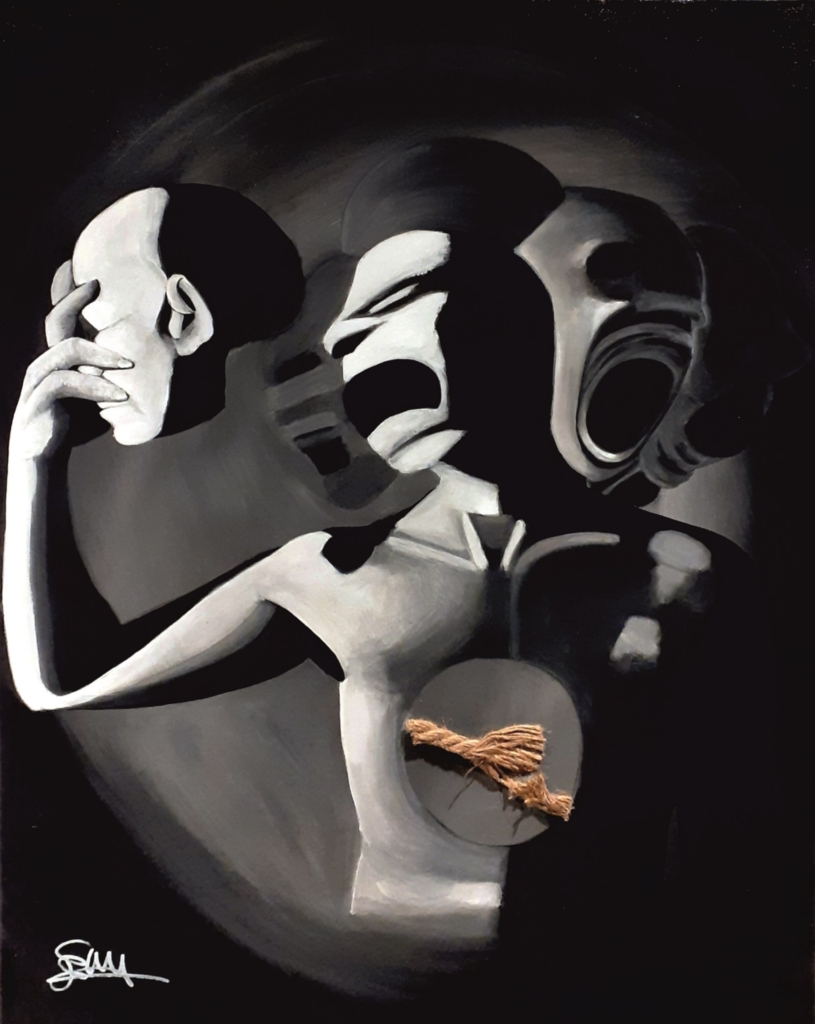
Negli ultimi due anni ha preso parte a molte mostre collettive, oltre a essere riuscita ad avere collezionisti che le commissionano le opere. Ci dice quali sono i suoi prossimi progetti?
Il mio unico progetto è quello di continuare il percorso che ho scelto di intraprendere. Il 2022 è iniziato con la programmazione di varie mostre ed eventi, per il resto si vedrà, sono sempre in crescita e cerco di dare sempre il mio meglio.
ELISA LA MANNA-CONTATTI
Email: elisalamanna87@gmail.com
Facebook: https://www.facebook.com/elisa.lamanna.7
Linkedin: https://www.linkedin.com/in/elisa-la-manna-542b20212/
Instagram: https://www.instagram.com/elisalamanna/
Marta Lock’s interviews:
Elisa La Manna, an in-depth analysis of the ills and cages of contemporary society
Young, sensitive, careful observer of the deepest folds that hide behind the looks of all the people she meets on her path, Elisa La Manna, despite having studied at the Art Institute where she graduated in 2011, began to paint, or rather to practice painting regularly, only in 2020, perhaps because it was in that darkest period in the history of the 21st century that her inner self felt the need to find an outburst, a liberating channel through which to cry out the discomforts, fears, uncertainties but also the manipulations to which contemporary man is constantly subjected. From that moment on, her artistic career became a succession of exhibitions and participation in painting competitions, during which she was noticed and appreciated by the public and experts thanks to her ability to bring out truths that are sometimes uncomfortable but undeniable, in front of which the observer cannot but reflect, letting himself be carried away by the artist’s introspection; her strong tendency to deepen and objectively analyse imperfections, cages confused with freedom, unconscious conditioning, but also the decontextualisation of the essential elements, those parts in evidence that go to make up the final message and which, although they appear to be unrelated to each other, in reality constitute the broad view and the basic concepts of the transversal reading of the observed typical of La Manna, makes her style part of Metaphysical Surrealism. As a result of her academic studies, she is able to experiment and mix techniques that are functional to the messages she wishes to imprint on her canvases, so to a base of acrylic colour she sometimes adds gold leaf, epoxy resin, coffee, wine, unusual materials that allow her to combine intention with action, feeling with the creative gesture, mind with emotion. Her young age does not prevent her from getting to the bottom of the meanings that life often conceals; in fact, perhaps it is precisely by virtue of the naturalness of her gaze that she is able to ask questions that most people do not ask, because it is easier to pretend not to see, to get used to, to fall into line rather than take note of uncomfortable realities. The canvas Modern Slave emphasises the network of innovations and comforts through which contemporary men and women feel free, such as purchasing power, time to be filled with a thousand commitments, smartphones thanks to which they can be connected with the world in a single click, and mass media thanks to which everything is available in real time; on the contrary, what should apparently make us better, more aware, happier, represents a gilded prison inside which the soul, the interiority, suffers because it feels alone, withered, powerless in the face of the vicious circle of cause and effect from which it seems impossible to escape and which the artist represents as a hamster on a rotating wheel. In the painting Media Influence, Elisa La Manna emphasises the extent to which human beings are incapable of forming critical thoughts due to the superficiality with which they sometimes tackle important contemporary issues, relying on a single voice that monopolises thought, inducing the viewer to accept only one version as valid, without going into detail or opening up to contradictions in order to have a broader and more impartial vision. Once again, therefore, the artist highlights the extent to which society tends to want to condition and engulf the individuality of the individual, who finds himself faced with the choice of either conforming and renouncing himself or going against the current, even though he knows he must be a voice outside the choir, perhaps more alone but certainly freer. Let us now get to know the talented Piedmontese artist in more detail.
Elisa, your artistic journey began many years after your graduation, can you explain what kept you away from painting and why the beginning of your real approach to the canvas coincided with the outbreak of the pandemic event that immobilized the entire world?
I attended art school for three years; for various reasons and needs, partly conditioned by the external environment, I had a period of transition, choosing another path, believing it to be the right one for me, but which over time, as well as making me feel bad, turned out to be worst than I imagined. The pandemic was a coincidence, I had started to have the idea of starting to paint again just before it all began; the confinement we were forced to undergo immediately afterwards was like closing one door to open another, within which I had time to find myself again and get back into the game on a path that I was already destined to take, despite the fact that I was lost and confused and had therefore moved away from it.
Your style of painting is decidedly captivating thanks to the metaphysical surrealist style, which is capable of imprinting impressions onto the canvas, but also thoughts and assessments on current life; do you think there is a way for modern man to escape from the gilded cages in which he finds himself? Can art be a means of reclaiming the freedom of the individual and inducing people to ask themselves questions, going deeper than the surface on which they usually stop?
I do not believe that art can get us out of our conditioning because we are so enslaved by a system where everyone looks after their own interests that we have forgotten about the common good; having to give up all those comforts to which most of us have become accustomed would lead to such a psychological crisis that people would not want to give them up. Just imagine what life would be like if we replaced our smartphone with a common mobile phone, or tried to stop working to devote ourselves exclusively to cultivating our needs and necessities. We have become part of a vicious circle that makes it too difficult to change course. For the majority, it is easier to go with the flow and not ask questions than to try to evaluate and change strategy. Fortunately this is not the case for everyone, there are always exceptions, but technology, the contemporary way of life that has been imposed on us, may have made us united digitally but divided from a human point of view. In my opinion, art plays an important role from this point of view, free creative expression is a way of communicating messages, a means where the individual can reflect and reflect.
What is the message you want to emerge from your artworks? And why did you choose Metaphysics as your pictorial approach?
I have always been a reflective person and I have always liked to observe things from a certain point of view. In my artworks I try to give a narration that goes beyond appearances, reality is observed in its many facets, I like to capture emotions and situations experienced by the individual in a certain context. The message I want to bring out is that of pausing to give voice to emotions and reflections that the individual escapes in his everyday life.
Are there any masters from the past who have inspired you or to whom you feel closest in terms of expressive intent?
I have always had a soft spot for artists such as Klimt, Dali, De Chirico and Frida Kahlo. Surrealism and Metaphysics are the artistic movements that have always fascinated me the most; as an expressive intent, I feel closest to the last three I mentioned.
In the last two years you have taken part in many group exhibitions, as well as succeeding in having collectors commission your works. Can you tell us what your next projects are?
My only project is to continue on the path I have chosen to take. The year 2022 has begun with the planning of various exhibitions and events, for the rest we will see, I am always growing and trying to give my best.
